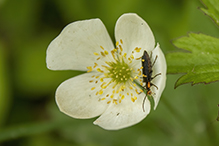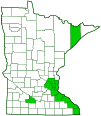wrinkled soldier beetle
(Podabrus rugosulus)
Conservation • Description • Habitat • Ecology • Distribution • Taxonomy
|
|
||||||||||||||
Description |
Podabrus rugosulus is a small soldier beetle that bears a passing resemblance to a lightning bug. It is very common in eastern United States east of the Great Plains and adjacent Canadian provinces. It is found from mid-May to mid-August on foliage in thickets, semi-open areas, fir plantations, apple orchards, tamarack bogs, and river shores. The body is soft, somewhat flattened, and elongated, ¼″ to ⅜″ (7 to 9 mm) long. The exoskeletal plate covering the thorax (pronotum) is wider than long but no more than 1.5 times as wide as long. It is widest near the base, much narrower at the front (apex), and the sides are broadly curved (bowed) outward. It is straight across at the front and does not conceal the head. It is glossy, dark brown or black in the middle, pale or reddish-yellow at the sides, and covered with large, closed punctures. On each side near the middle there is a small, raised, five-sided projection (tubercle) pointing to the side. The wing covers (elytra) are leathery, flexible, 2.5 times as long as wide, almost 5 times as long as the pronotum, and completely cover the abdomen. They are almost parallel near the base, gently arced in the middle, widest just beyond the middle, and rounded at the tip. They are rough, entirely black, have two slightly raised ridges, and are covered with minute punctures. The plate between the wing bases (scutellum) is well developed and visible but small and black. The head is black. In front of the eyes it is wider than long. It narrows behind the eyes forming a distinct “neck” that is visible from above, not hidden by the pronotum. The edges of the collar-like plate wrapping around the head (postocciput) merge into a single closed suture (gular suture) on the throat. The face is yellow. The antennae have 11 segments and are dark brown to black. The third segment is longer than the second. The legs are long, slender, and entirely black. The end part of each leg (tarsus), corresponding to the foot, has 5 segments. The fourth segment is expanded and has a lobe on the underside. On both sexes the claw at the end of the tarsus is narrowly cleft and has a long triangular tooth. |
Size |
Total length: ¼″ to ⅜″ |
Similar Species |
Habitat |
Foliage in thickets, semi-open areas, fir plantations, apple orchards, tamarack bogs, and river shores. |
Ecology |
Season |
Mid-May to mid-August |
Behavior |
These are heavy fliers. They do not travel far from their place of origin. On hot days they are active in the morning, become inactive at midday, and active again in the relatively cool evening. |
Life Cycle |
|
Larva Food |
|
Adult Food |
Aphids. Adults have been reported preying on the balsam twig aphid (Mindarus abietinus), a European species that was introduced into North America in 1879 and now occurs from coast to coast. |
Distribution |
||
|
Sources |
|
| 10/17/2024 | ||
Occurrence |
||
Very common |
||
Taxonomy |
|
Order |
Coleoptera (Beetles) |
Suborder |
Polyphaga (Water, Rove, Scarab, Long-horned, Leaf, and Snout Beetles) |
Infraorder |
Elateriformia |
Superfamily |
Elateroidea (click, firefly and soldier beetles) |
Family |
Cantharidae (soldier beetles) |
Subfamily |
Cantharinae |
Tribe |
Podabrini |
Genus |
Podabrus |
Subordinate Taxa |
|
|
|
Synonyms |
|
|
|
Common Names |
|
wrinkled soldier beetle |
|
Glossary
Elytra
The hardened or leathery forewings of beetles used to protect the fragile hindwings, which are used for flying. Singular: elytron.
Pronotum
The exoskeletal plate on the upper side of the first segment of the thorax of an insect.
Scutellum
The exoskeletal plate covering the rearward (posterior) part of the middle segment of the thorax in some insects. In Coleoptera, Hemiptera, and Homoptera, the dorsal, often triangular plate behind the pronotum and between the bases of the front wings. In Diptera, the exoskeletal plate between the abdomen and the thorax.
Tarsus
On insects, the last two to five subdivisions of the leg, attached to the tibia; the foot. On spiders, the last segment of the leg. Plural: tarsi.
Visitor Photos |
||
Share your photo of this insect. |
||
This button not working for you? |
||
Alfredo Colon |
||
 |
||
 |
 |
|
 |
||
Greg Watson |
 |
MinnesotaSeasons.com Photos |
||
|
||
|
||

Slideshows |
|

Visitor Videos |
||
Share your video of this insect. |
||
This button not working for you? |
||
|
Other Videos |
||
Podabrus rugosulus, SOLDIER BEETLE, feeding |
About
Jun 10, 2020 Podabrus rugosulus, SOLDIER BEETLE, feeding. Busse Woods FP. , IL 6/24/2017 3015779 |

Visitor Sightings |
||
Report a sighting of this insect. |
||
This button not working for you? |
||
Alfredo Colon |
Location: Albany, NY |
 |
Alfredo Colon |
Location: Albany, NY |
 |
Alfredo Colon |
Location: Albany, NY |
 |
Alfredo Colon |
Location: Albany, NY |
 |
| Greg Watson 6/12/2022 |
Location: Wagon Wheel Trail, La Crescent, MN |
 |
| Alfredo Colon 6/10/2018 |
Location: Woodbury, Minnesota |
 |
MinnesotaSeasons.com Sightings |
||
|

Created: 11/7/2018 Last Updated: © MinnesotaSeasons.com. All rights reserved. |

